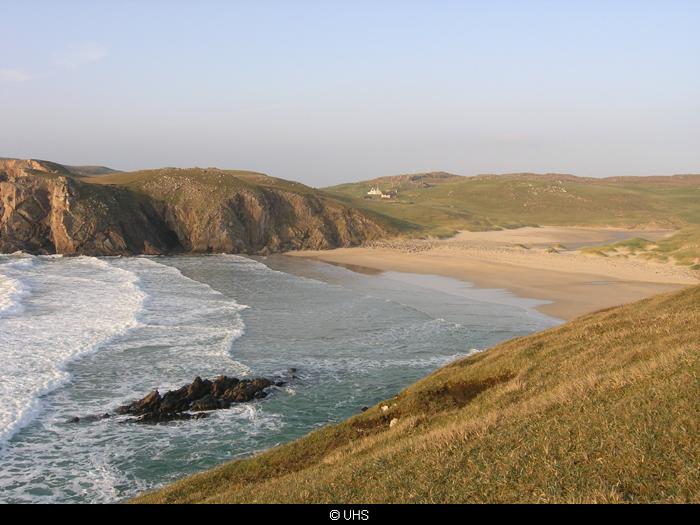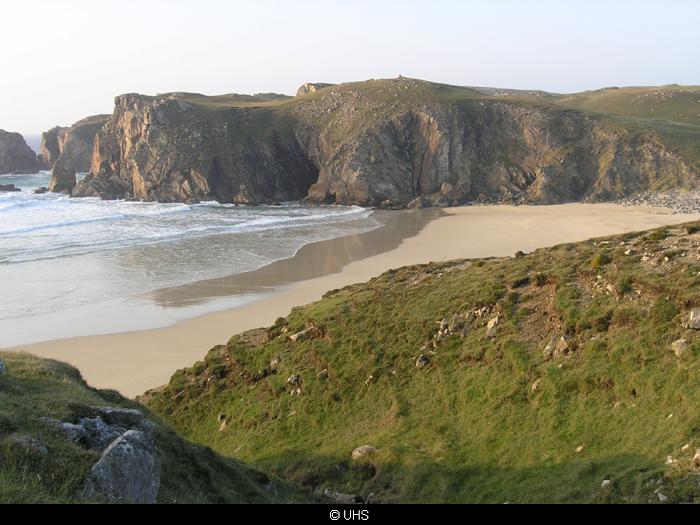8674: The Grana rescue at Mangersta, Uig
Christina Mackay – Uig’s Victorian Heroine
In 1872, the people of Mangersta in Uig were for the most part resettled in Doune Carloway. They were having serious problems with salty summer gales destroying their potato crop. However not everyone went north. Donald Macleod was courting in Brenish, and he stayed behind.
The village of Mangersta was then let to Donald Mackay from Valtos. He was married to Christina (formally Macrae) of Timsgarry. They lived in the farmhouse which was demolished fairly recently. In 1896 some of the family were still at home. Iain was attending the school in Islivig, and Fearchair was only two years old. It was the middle of October, and the weather was terrible – a gale had been blowing for days. Out at sea a Danish schooner was being battered by relentless winds and raging waves. On the evening of 21st this boat was in a sorry state. It had lost its bowsprit, the starboard bow was smashed in, and the bulwark from the stem to opposite the foremast was carried away along with the lifeboats. The sails were torn to ribbons, and excessive strain on the hull had caused it to leak. To make matters even worse, the cargo of dried fish had shifted. The schooner was completely helpless. The crew hoisted distress signals but no one noticed, so the Captain decided their only hope was to run ashore. He spotted a sandy creek and the whole boat was carried in on the crest of a gigantic wave. They scraped over some rocks and then hit the sand. It was four o’clock in the afternoon, and Iain Mackay was on his way home from school. He enjoyed walking along the cliffs, especially in these conditions, even though his mother made him promise to keep to the track. He spotted the stricken vessel being driven ashore. On her bow was written the word GRANA. He ran home to tell of his exciting news.
This was not the first time that this particular boat had been wrecked. In 1868, the ‘Emilie’, a French schooner, was badly damaged in a storm off northern Iceland. She struggled into Siglufjord and was abandoned by her crew. The local people saw great potential in her timbers, and planned to re-roof their houses. They purchased the ship for 40. The vessel lay on the beach ready to be stripped, but the minister advised them to repair the damage, and use the ship to carry fish to market. In that way they could make good livings, and afford to buy timber for their houses, and a lot more. The only problem was raising the money to pay for the repairs. There were no banks in Iceland, and the Danish merchants were less than helpful, viewing the idea as competition. The boat lay high and dry, unattended for many months and the weather began to take its toll. The paint peeled off, and the whole ship turned grey. The merchants mocked the villagers, and renamed the ‘Emilie’ the ‘Grana’ – the grey one. It was two years since she was beached, but the villagers had been stealthily collecting little sums of money, and in 1870 they started work on the repairs. They set up a company called Granufelagith – The Merchants of the Grana. It turned out to be very successful and soon they had two more boats. Even more amazing, their leader Tryggaie Gummerson was to set up the very first Iceland bank! Most of their trade was actually carrying cargo between Iceland and Denmark, but they also made trips to other ports. On the 11th October 1896 they left Iceland bound for Liverpool. The voyage was uneventful until they were hit by a terrible storm just off the Faroe Islands and this eventually drove them onto the beach at Mangersta.
Iain ran the rest of the way home to find that his father was not at there, so instead he described to his mother what he had seen from the cliffs. She realised that the crew would be in danger of being drowned. She already knew of the distressing job of bury the bodies of dead sailors found on the shore. If they were not local, then they would be buried in the dunes. Without her intervention, there would inevitably have to be more burials. She didn’t give the matter a second thought; she just scooped up Fearchair, wrapped him in a shawl and ran down to the bay. The two year old was carefully lodged in a crevice in the rocks at the top of the beach. The ship was stranded on the sand close by Stac na Sgarbh, with the sea completely surrounding it. The astonished seamen must have thought their prayers had been answered, and the angel they had called for, had been sent to rescue them. Without any hesitation Christina Mackay waded into the raging sea, shouting to the crew to throw down a line. The surf was boiling around her; she struggled against the undertow, and braced herself for each breaker. Eventually despite the weight of her sodden tweed skirts, she managed to grasp the rope without being swept off her feet. With all her strength, (Hebridean women of this period certainly had great strength), she hauled the rope up the beach. With the help of son Iain, she managed to make it fast to some jagged rocks at the upper end of the shore.
One by one, the exhausted crew slithered down the rope to safety. They had sleeplessly endured the storm for four days, and it was all they could do to stagger up to the warmth and comfort of the farmhouse. This kindly woman then set about providing the men with food and drink, and a place to rest their weary heads. In all they stayed for a week, until they were recovered from their ordeal. They travelled to Stornoway, and then they were homeward bound. The Captain stayed on for some time selling the cargo of salt fish. When he was ready to leave, he asked Mrs. Mackay how much he owed her for the hospitality shown to himself and his crew. She refused to consider such a matter and wouldn’t accept a brown penny. "No financial gain was required for showing kindness and mercy to those in need", she said. Captain Peterson’s eyes filled with tears, and he said he’d never seen such kindness as that which he and his men had experienced at Mangersta Farm.
However, this remarkable woman did not go unrewarded. The Danish Government presented her with an expensive marble clock, with an inscription on it, which she cherished till her dying day. The clock has long since ceased to chime, but somewhere in South Africa is the inscription plate. John was very proud of his mother’s bravery that day, and he kept the plate himself after her death. Christina Mackay became famous throughout the country when her story was published in The Strand Magazine in December 1897.
Before the First World War, Brenish had become so overcrowded that it was decided to close the farm at Mangersta and resettle it with the landless cottars. The Mackay’s were put off the farm, and it is assumed that they joined with the Macraes of Timsgarry Farm (Christina was the sister of John Macrae), and returned to the Kintail area, from whence they had originated some generations earlier. Most of their children ended up emigrating to Rhodesia and South Africa. Iain, who kept the inscription plate from the clock, worked in the Transvaal diamond mines and later lived very comfortably in Johannesburg. Fearchair also did very well for himself; he ended up owning the Sarbola Gold Mine in Bulawayo, Rhodesia. One sister, Flora Eilidh lived in Capetown and another stayed in Pretoria.
The remains of the wreck are still on Mangersta beach, including the anchor chain. But these only appear after exceptional weather conditions cause the sand to shift. Some of the timbers of the boat, which were originally destined for the roofs of the houses of Siglufjord, can be seen in the roof of the old house at No.1, Islivig, which was being built by Donald Macaulay at the time.
Many of the details of this story came from Fearchair himself, who returned to the place of his birth a few times – his last visit was in 1964. Murdo Macleod, of 13 Crowlista recorded the story in Gaelic in the 1960s.
Thanks are due to Ina Macdonald for translation, and to John Macdonald and Dan Buchanan for information.
Dave Roberts; information from Prabos.
Details
- Record Type:
- Story, Report or Tradition
- Date:
- 1896
- Type Of Story Report Tradition:
- Story
- Record Maintained by:
- CEU

